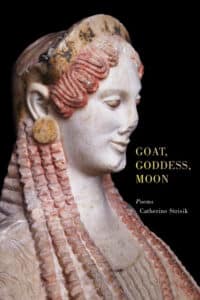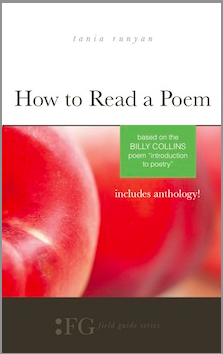Catherine Strisik explores famous history in poetry
It’s coincidental, but my poetry reading this week has taken me to Greece. Tuesday, it was The Presence of One Word by Andrea Potos. Today, it’s a journey through family history and tradition.
In Goat, Goddess, Moon: Poems, Catherine Strisik poetically tells story after story of family history and experiences. And the family is a Greek one. We travel with her to the villages and landscapes of her forebears in northern Greece. (Part 1 of the collection lists the villages of Amygdalies and Trapezitsa, and I Googled them to find them on a map.)
Not surprisingly, perhaps, she associates the family with food and herbs, like her great-grandmother who came to America in 1916 carrying the smell of chamomile. Strisik adds Kalimera cake (of which there are several kinds), basil and dill for her grandfather, psomi bread from the bakery, soup, and friend eggplant sandwiches. The food comes the villages of her ancestors, and it is often prepared communally.
The two villages she cites are both in the area of Grevena, a town and municipality in northern Greece or western Macedonia. And the people there know their food.
Grevená People

flaunting our flaws, our fractured English
and our wooden-handled spoons and give
the appearance of the attentive, square and
straight-backed. We gather to stir lamb shank
stew. Within the stir, a hand gesture’s resemblance,
our language prepared with the moisture and baa
of the mother lamb. When I ask for a taste, speak
quickly about the ingredients, you each hold
a spoon to my mouth. The ingredients taste
of wool and shepherds. I taste our
resemblance, our sacrifice. We have fallen
in love because it is June, and raining
hard. For a moment, we gaze
toward the flock on the hillside.
Strisik goes beyond the villages to what she calls her own labyrinth, the city of Heraklion on the island of Crete. She gets lost following its winding street, but (luckily) she doesn’t encounter her own minotaur.
She does find a few white-haired men seated and talking in a circle, all with the cigarettes and polished shoes. She finds lady beetles, a cat begging for food, and the fish seller who tells Strisik that “you look like one of us.” The title poem is centered here in Heraklion; she discovers that what she is seeing is blending with myth.

Catherine Strisik
In the final section of the collection, Strisik considers her own name, “Katerina.” She is still in Crete, “the island of remnants.” She says she uses her name “only in church when receiving communion,” but she explores its sounds, its textures, and its meaning. She’s becoming a kind of Greek woman, finding her roots and finding her place in both her family and her poetry.
Strisik previously published two full collections, The Mistress and Thousand-Cricket Song, and the chapbook Insectum Gravitis. She serves as editor of the Taos, New Mexico, Journal of Poetry and is a former poet laureate of Taos. She’s received numerous poetry awards and recognitions, and her poems have been translated into Greek, Persian, and Bulgarian. She lives in New Mexico and Massachusetts.
If your own heritage is Greek, or if you have visited or long to visit Greece, Goat, Goddess, Moon might make a good companion. The poems speak to the villages, the food, and the landscapes, and even more to the people, people like Strisik herself.
Photo by Marco Nurnbrger, Creative Commons, via Flickr. Post by Glynn Young.
How to Read a Poem uses images like the mouse, the hive, the switch (from the Billy Collins poem)—to guide readers into new ways of understanding poems. Anthology included.
“I require all our incoming poetry students—in the MFA I direct—to buy and read this book.”
—Jeanetta Calhoun Mish
- Poets and Poems: Peter Murphy and “You Too Were Once on Fire” - October 14, 2025
- “Your Accent! You Can’t Be from New Orleans!” - October 9, 2025
- Poets and Poems: Donna Vorreyer and “Unrivered” - October 7, 2025


Leave a Reply